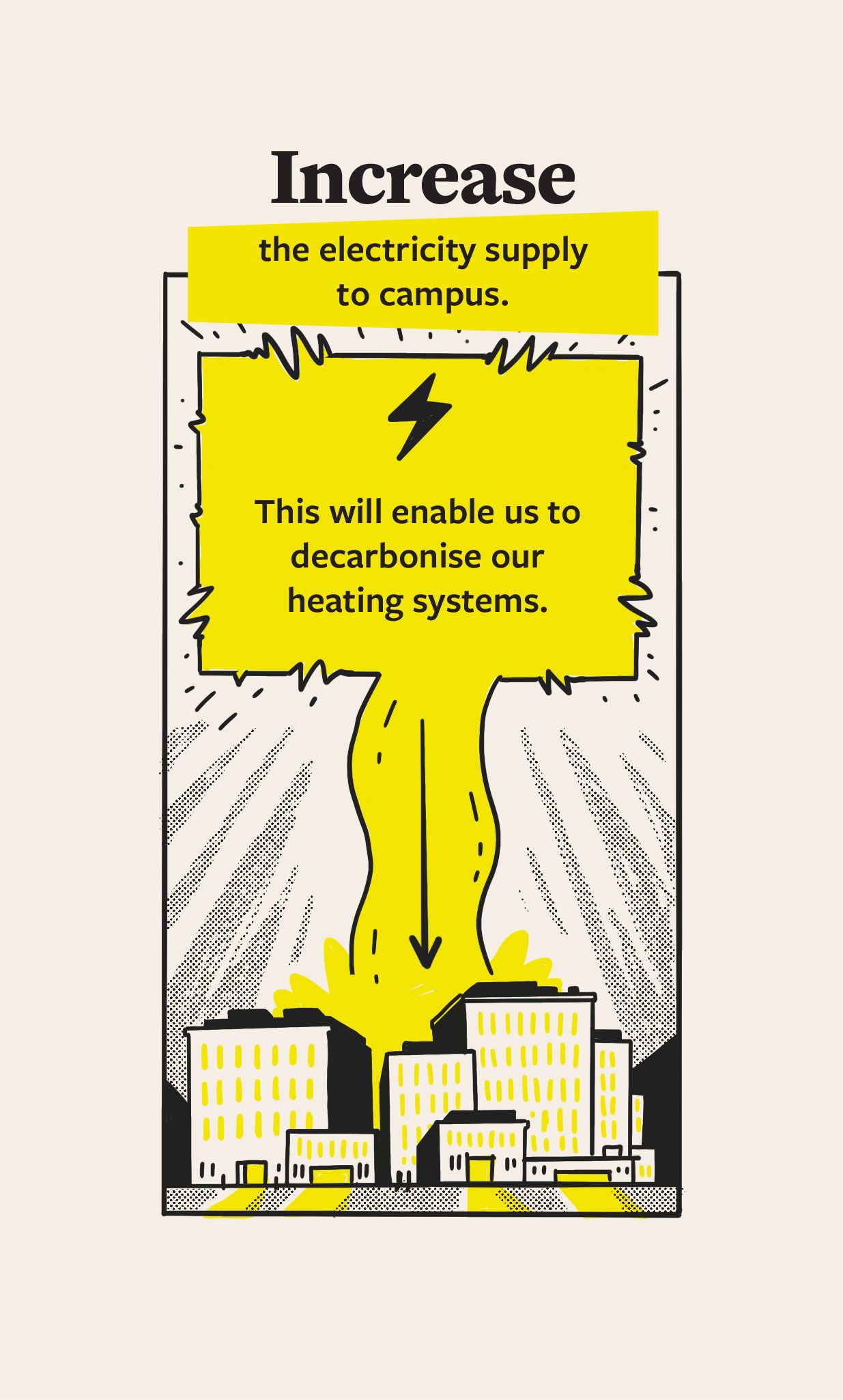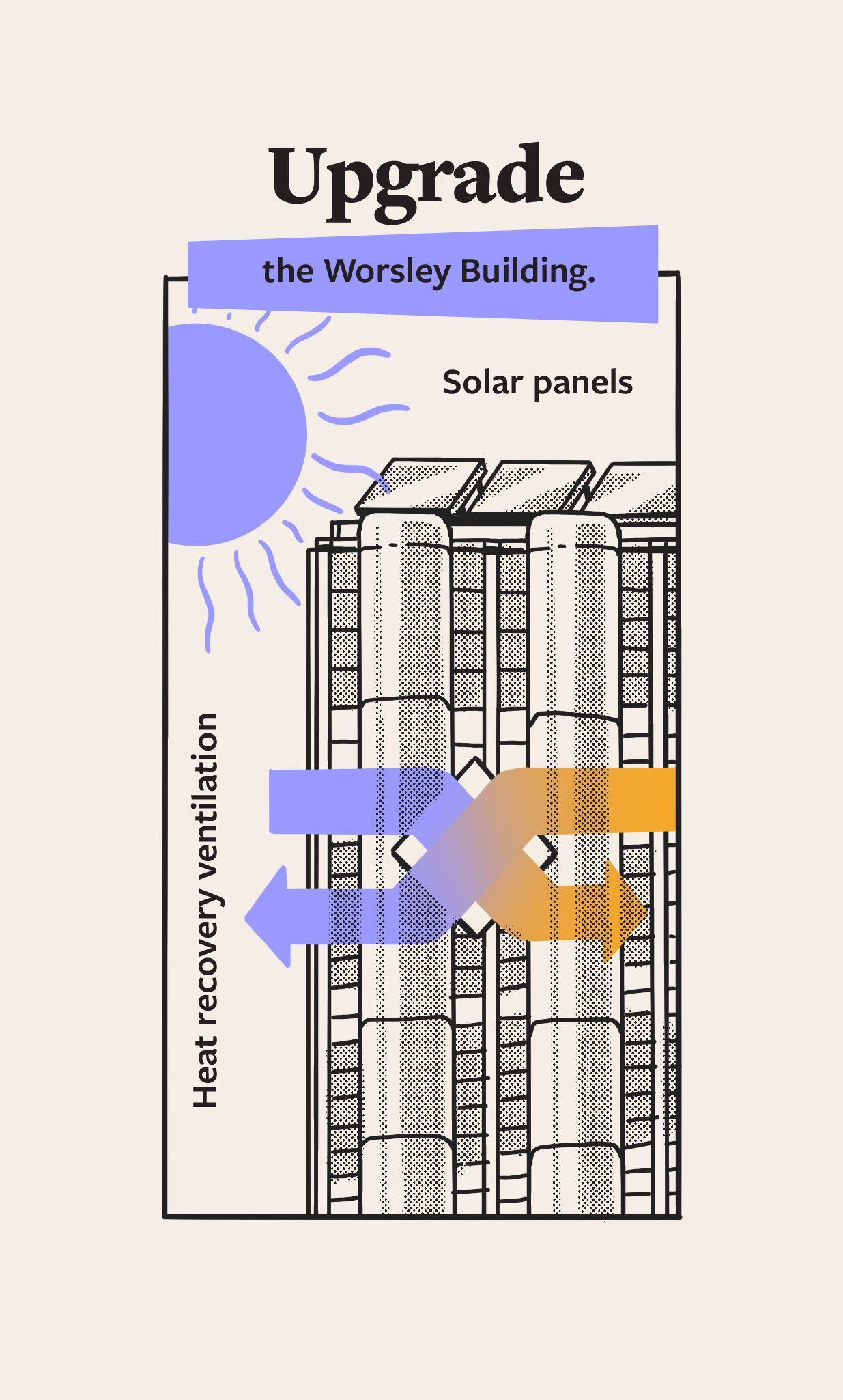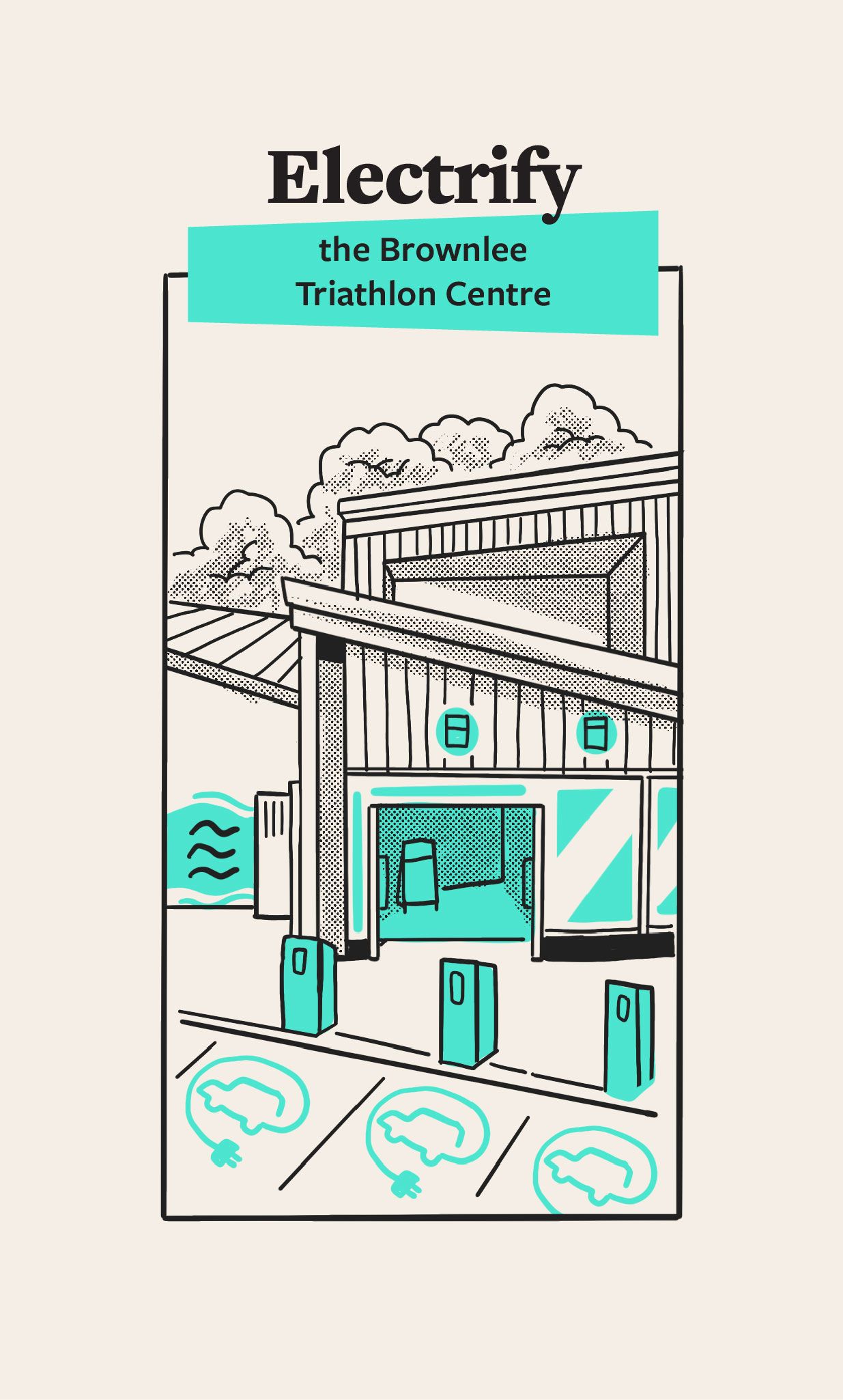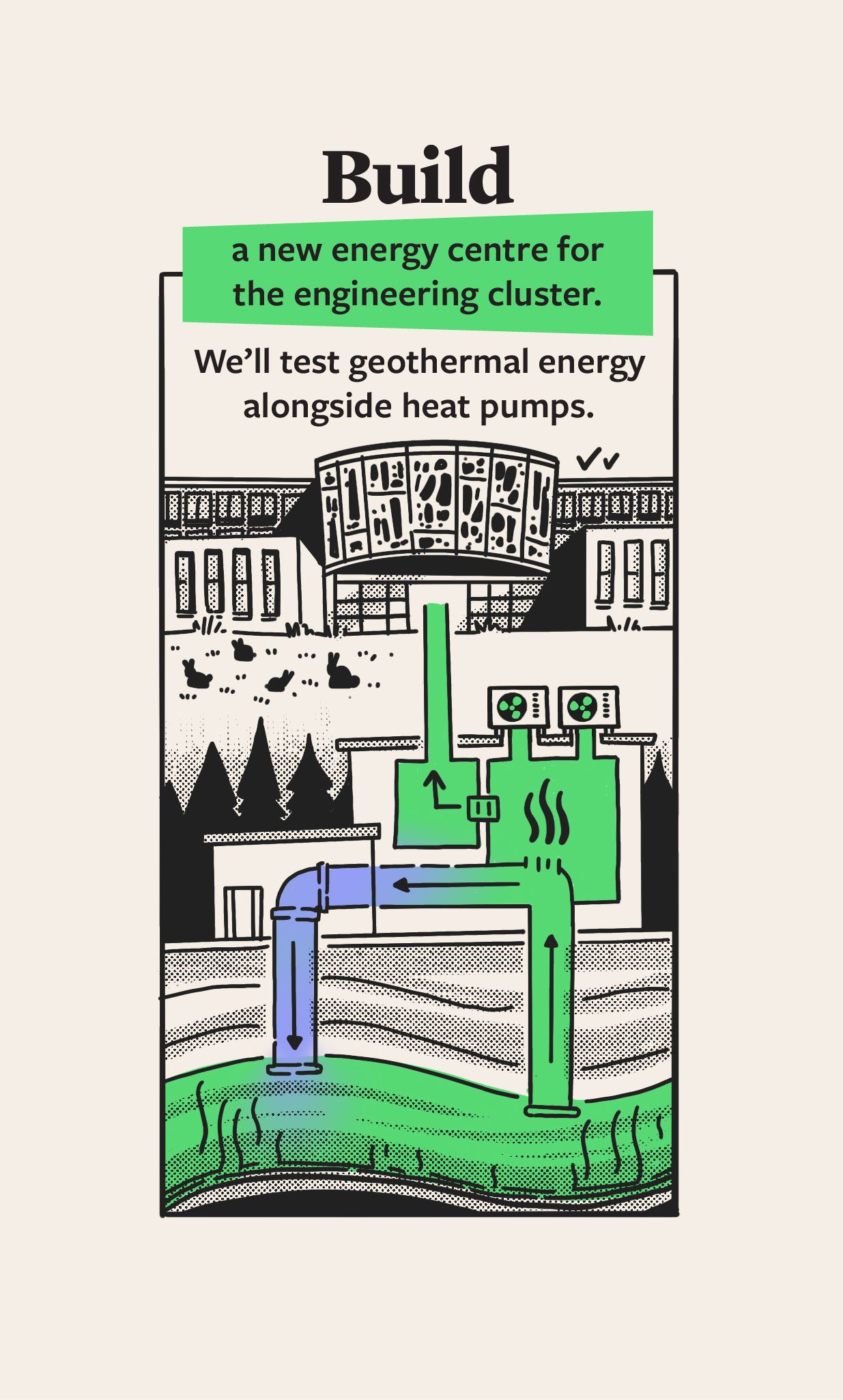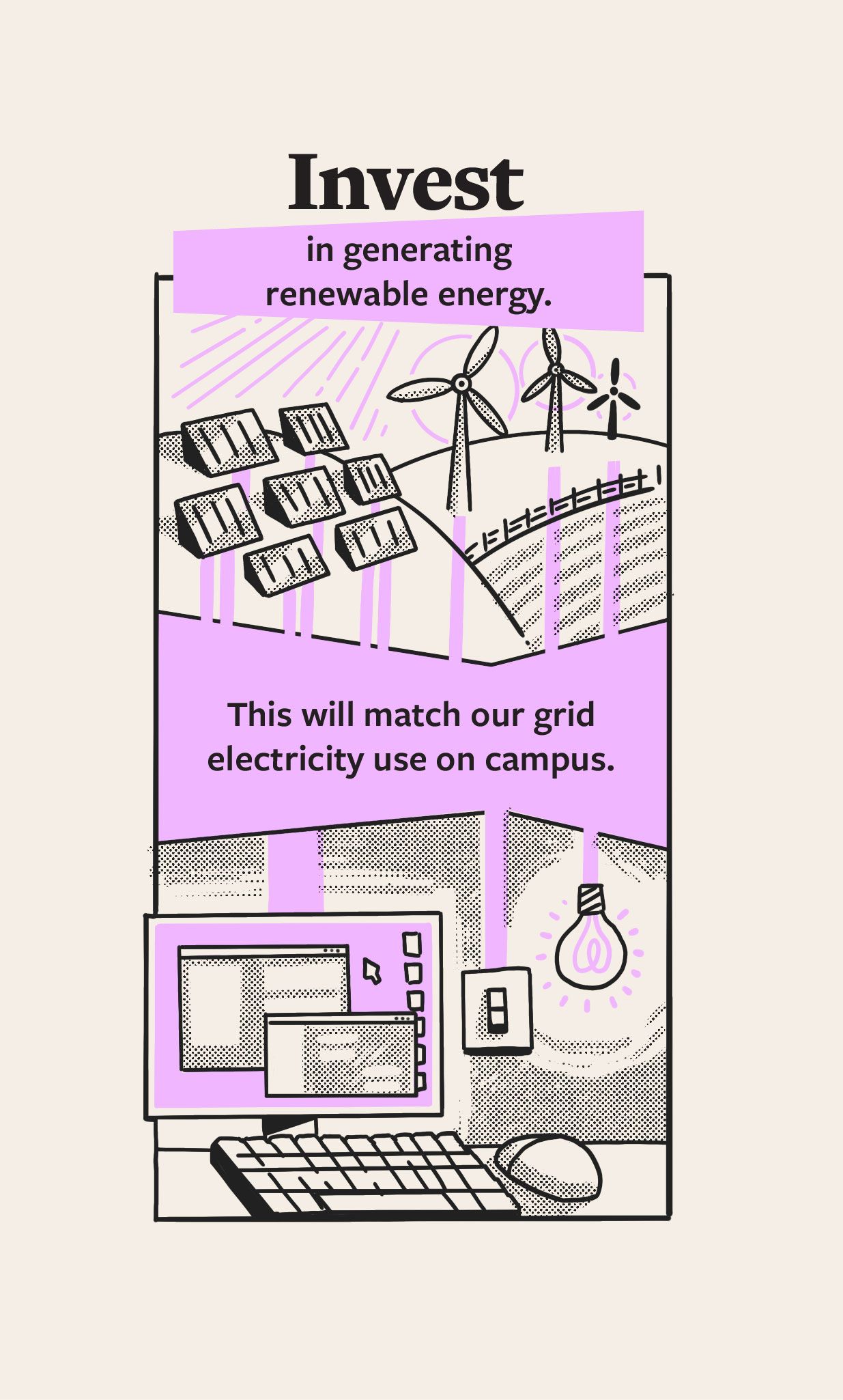Our Net Zero Delivery Plan

In order to reach our net zero target we need to tackle the emissions created by heating and powering our buildings. These make up two thirds of the emissions we need to eliminate.
To do this we need to make changes to our buildings and infrastructure so that they use less energy. We also need to ensure that the energy we use comes from renewable sources.
Our Net Zero Delivery Plan outlines how we will do this, turning the ambition set out in our Pathway to Net Zero into a practical, deliverable plan for our estate.
It outlines the key projects which have been identified as the most effective ways to reduce emissions on campus, including:
- securing an increased electrical supply to campus which will allow us to decarbonise our heating systems;
- upgrading the Worsley building with heat recovery ventilation and solar panels;
- fully electrifying the Brownlee Centre;
- building a new energy centre for the Engineering Cluster of buildings, potentially incorporating the use of geothermal energy;
- and investing in new renewable energy.
You can explore these projects further on this page. You can also follow our progress towards net zero in more detail on our Climate Plan Reporting page.
1. Increased electrical supply
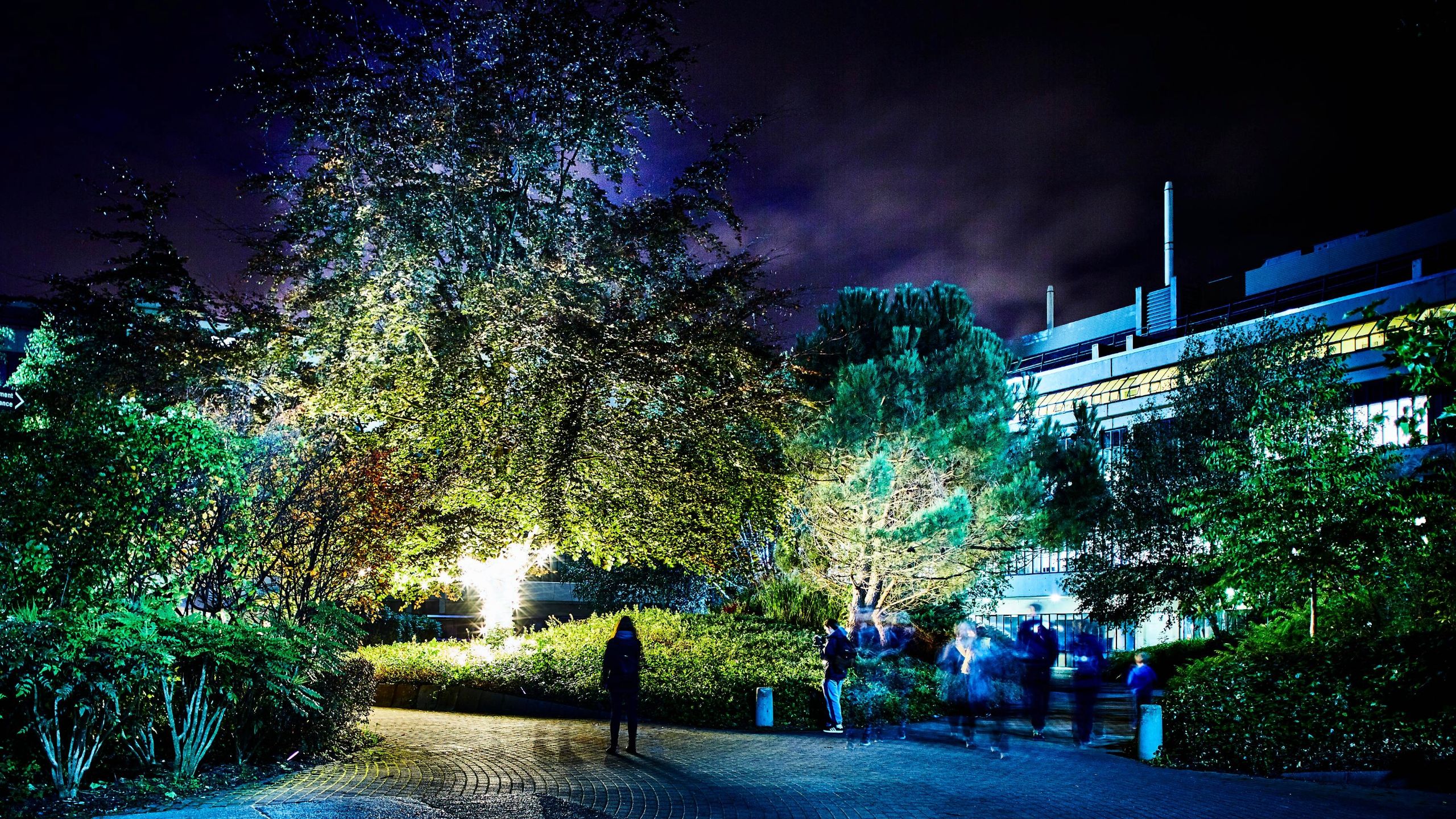
An increased electrical supply will allow us to move our heating system away from fossil fuels, which will deliver large scale and cost-efficient emissions reductions and go a long way to delivering our targets.
Whilst it might sound straightforward, it is a huge piece of work which is made more complicated by the fact that we share elements of the heating network with Leeds Teaching Hospitals Trust (LTHT).
Careful co-ordination with LTHT is needed, and a new group has been created to drive forward this work.
Key milestones:
- Complete: Calculate future energy requirements across campus
- Complete: Request quote for increased supply from Northern Powergrid
- Complete: Place order for increased electrical supply from Northern Powergrid
- In progress: Develop and agree plans to expand sub station capacity
- In progress: Develop plans to decarbonise heating network
- Carry out building work to expand sub station capacity
- Receive electrical supply from Northern Powergrid
- Implement decarbonisation plans for heating network
Latest updates:
- Quarterly update - Dec-Feb 2025: Placed an order with Northern Powergrid (NPG) for the required additional electricity capacity to campus to deliver our electrification plans.
- Quarterly update - Sep-Nov 2024: Received a quote from Northern Powergrid (NPG) for the additional electricity capacity required to deliver our net zero plans, and initiated approval processes.
- Quarterly update - Jun-Aug 2024: Formally requested a quote from Northern Powergrid for the additional electricity capacity required to deliver net zero.
- Quarterly update - Sep-Nov 2023: Agreed the additional electricity capacity required to deliver net zero and meet the University’s future needs.
2. Upgrading the Worsley Building
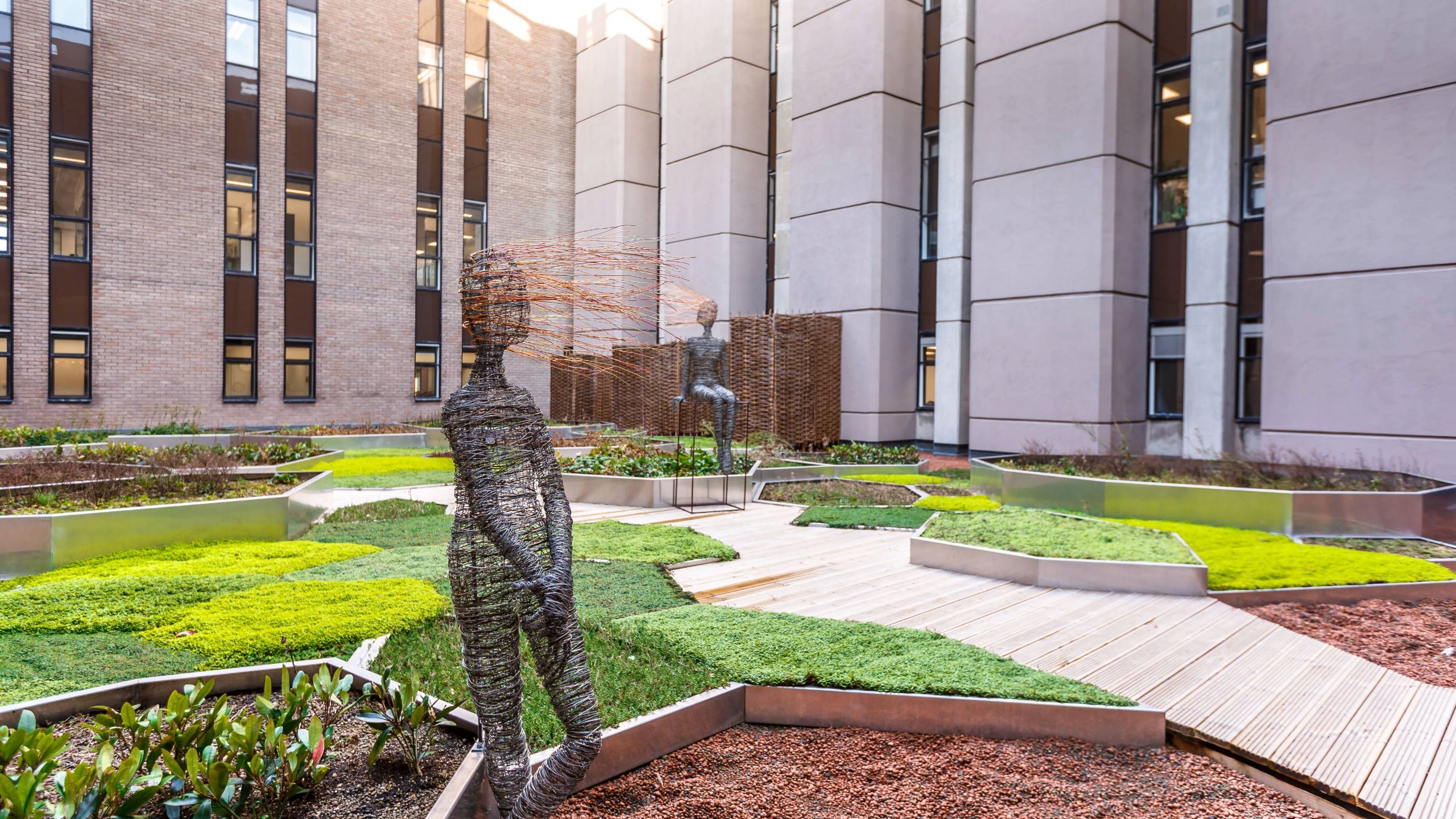
We plan to install a new heat recovery ventilation system in the Worsley Building, which will save around 1,800 tonnes of CO2e each year and is one of the most effective ways to reduce emissions in this high energy use building. Heat recovery ventilation systems work by using the warm air being extracted from the building to help heat the fresh air coming in, reducing the need for the heating systems to keep the building at the right temperature.
We will also be installing solar panels on the Worsley Building which will help support the high energy needs of the building, and reduce the amount of electricity needed from the national grid.
Key milestones:
Ventilation system:
- In progress: Develop designs for new ventilation system
- Obtain required approvals for work - expected spring 2026
- Begin work - expected 2026
Solar panels:
- Complete: Confirm designs
- Complete: Tender for contractor
- Complete: Appoint contractor
- Begin installation - expected 2026
Latest updates:
- Quarterly update - Sep-Nov 2025: Appointed a contractor to install solar PV on the Worsley building.
- Quarterly update - Sep-Nov 2025: Commenced final detailed design stages (RIBA stage 4) for the Worsley and Engineering Cluster projects.
- Quarterly update - Jun-Aug 2025: Published tender to install solar PV on the Worsley building.
- Quarterly update - Dec-Feb 2025: Awarded construction partner contract to Vinci, a tier 1 company who will lead on detailed designs and construction of the phase 1 major capital projects (Worsley Building and Engineering Cluster).
- Quarterly update - Sep-Nov 2024: Progressed the tender for a construction partner to deliver detailed designs on the Worsley Building and Engineering Cluster projects, as part of our phase 1 delivery of the Net Zero Delivery Plan.
- Quarterly update - Jun-Aug 2023: Commenced detailed design on the building and energy infrastructure projects identified within the Net Zero Delivery Plan.
3. Electrify the Brownlee Centre
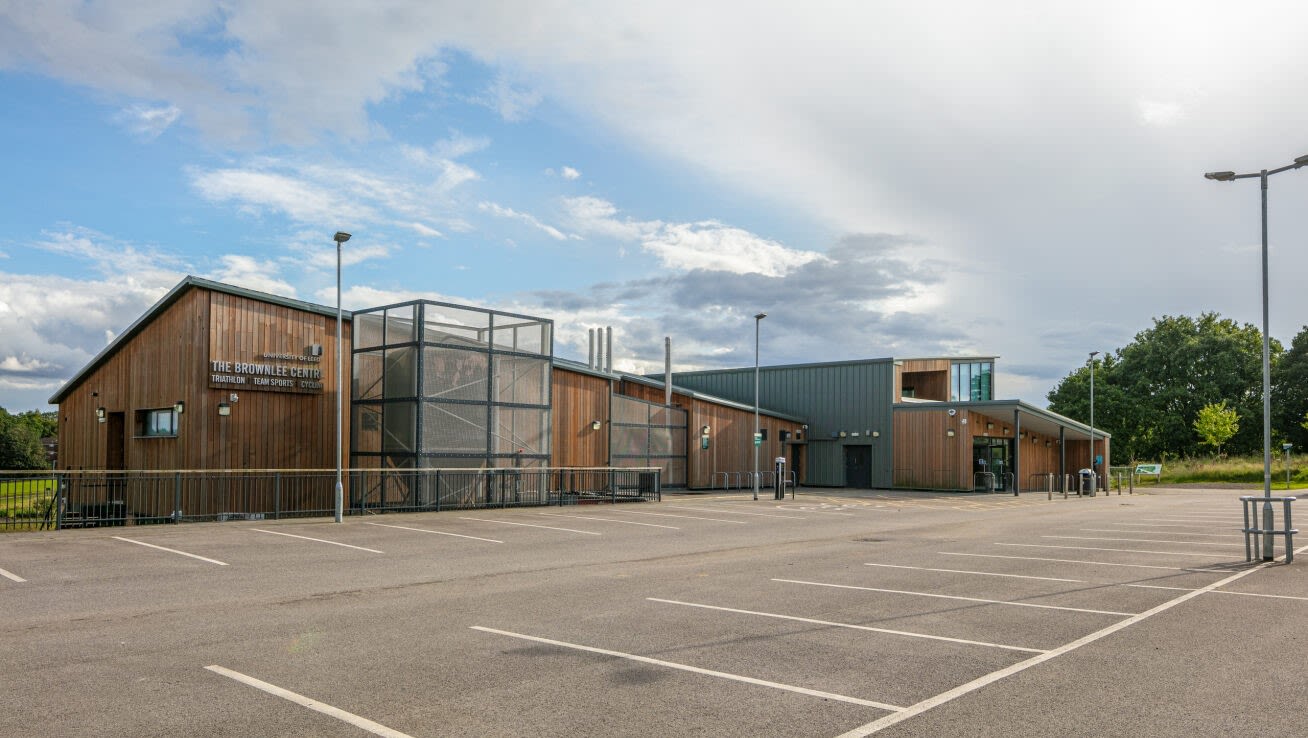
We’ve replaced the heating system at the Brownlee Triathlon Centre with air source heat pumps. This makes the whole site – which includes the Bodington Football Hub - fully powered by electricity. Once we have invested in a new source of renewable electricity this means that heating and powering the site will not create any greenhouse gases. We’ve also installed new electric vehicle chargers to help support sustainable travel to the site for staff, students and visitors.
Key milestones:
- Complete: Finalise plans for electrification
- Complete: Install electric vehicle chargers on site
- Complete: Install air source heat pumps on site
- Project completed September 2024
Latest updates:
- News - September 2024: New Brownlee Centre heat pumps power University's net zero drive
- Quarterly Update - Dec-Mar 2024: Brought forward the delivery of the decarbonisation of the Brownlee Centre using air source heat pumps to deliver earlier emissions reductions.
- News - Feb 2024: Decarbonising the Brownlee Centre
- News - July 2023: University increases number of electric vehicle charging points
4. Build a new energy centre for the Engineering cluster
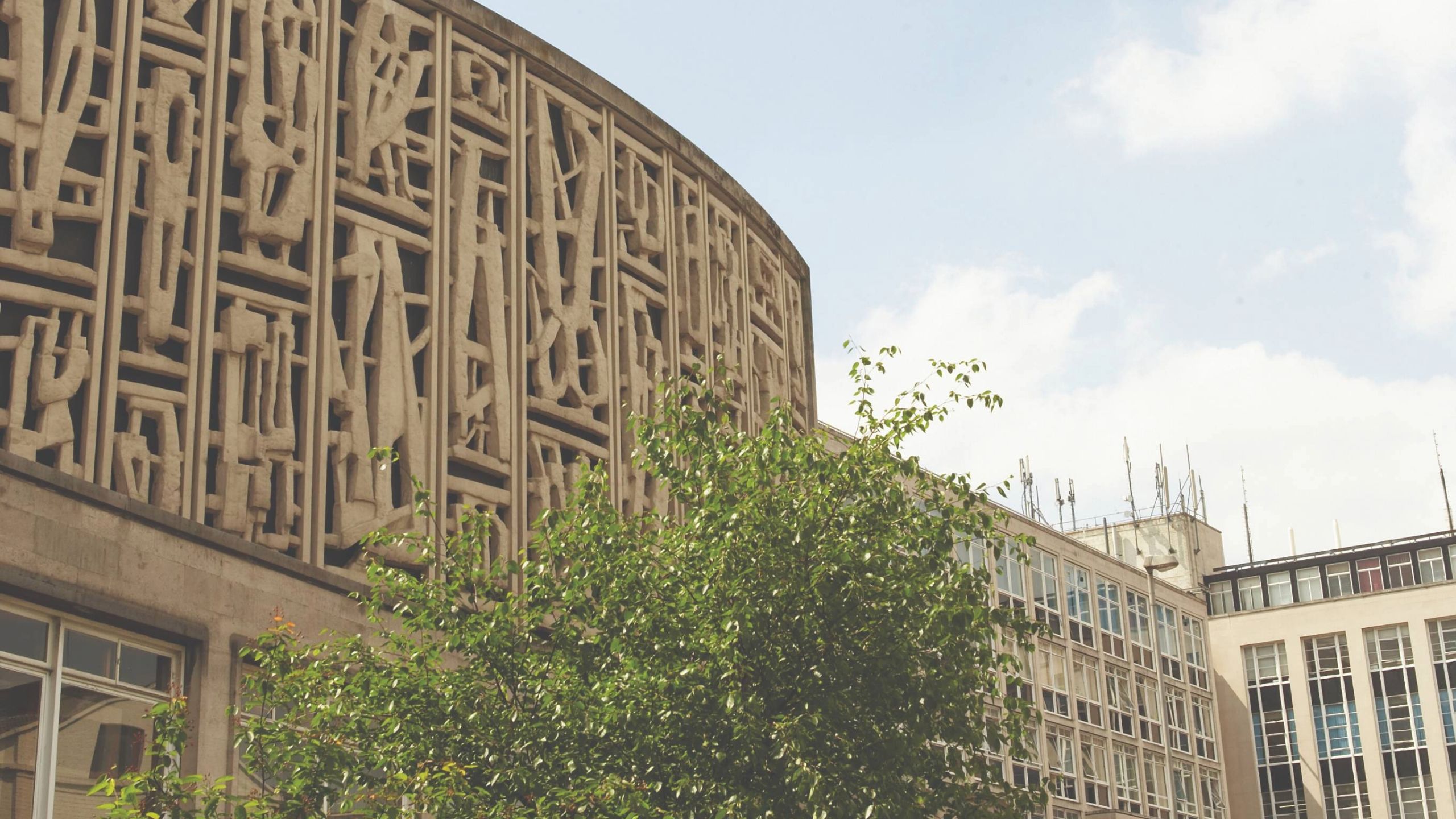
Being the furthest group of buildings away on our steam heating network means that energy is lost on route to this cluster, which includes the Schools of Mechanical Engineering, Civil Engineering and Chemical & Process Engineering, Henry Price hall of residence and the Bragg building.
By installing a new local energy centre to provide all the heating needs for the buildings it serves we can almost fully decarbonise the heating systems within these buildings.
Air source heat pumps will be a key part of the solution for this cluster, with geothermal heat used alongside these to provide a safe, efficient, sustainable solution.
Key milestones:
- Complete: Carry out exploratory work to test the potential for geothermal energy
- Complete: Assess potential for geothermal energy on campus - expected 2024
- In progress: Develop plans for new energy centre - expected 2025-2026
- Obtain required permissions for energy centre - expected spring 2026
- Build new energy centre - expected late 2026
- Connect energy centre to supply buildings - expected 2026-2027
Latest updates:
- Quarterly update - Sep-Nov 2025: Commenced final detailed design stages (RIBA stage 4) for the Worsley and Engineering Cluster projects.
- Blog - April 2025: Geothermal Campus Living Lab.
- Blog - March 2025: Turning ambitious net zero plans into action ('positive results from geothermal test drilling' section)
- Quarterly update - Dec-Feb 2025: Awarded construction partner contract to Vinci, a tier 1 company who will lead on detailed designs and construction of the phase 1 major capital projects (Worsley Building and Engineering Cluster).
- Quarterly update - Sep-Nov 2024: Progressed the tender for a construction partner to deliver detailed designs on the Worsley Building and Engineering Cluster projects, as part of our phase 1 delivery of the Net Zero Delivery Plan.
- Quarterly update - Sep-Nov 2024: Completed analysis on the outcome of geothermal drilling on campus, which has shown positive results that will be used to inform design for the Engineering Cluster projects.
- Quarterly update - Jun-Aug 2024: Completed exploratory drilling for geothermal energy on campus.
- News - May 2024: First phase of campus geothermal energy project nears completion
- Blog - Jan 2024: Exploring geothermal energy on campus - what is it and why are we doing it?
- Estates project page: Geothermal drilling on campus
5. Investing in renewable energy
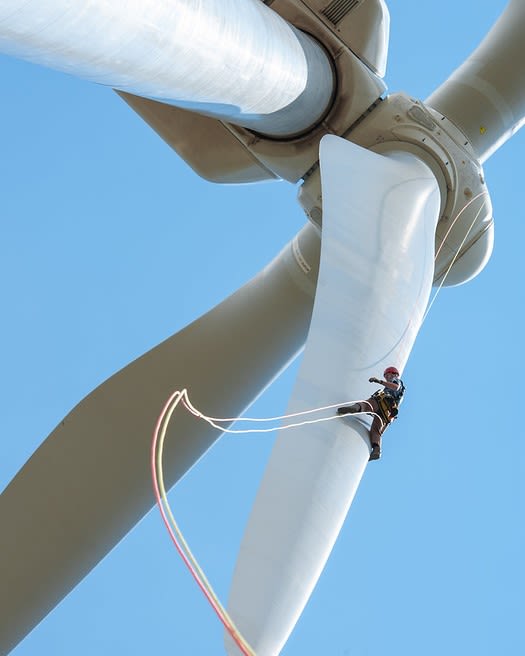
Renewable energy generation is a high priority for our Net Zero Delivery Plan. We believe it is important that we take responsibility for our own energy and contribute to the wider UK energy transition.
We will investigate options for generating renewable energy on our estate, alongside switching our electricity supply to contract with deep green energy providers who commit to investing profits into new renewable energy generation.
Once in place, this will save around 2,000 tonnes of CO2e (carbon dioxide equivalent) each year.
Key milestones:
- Complete: Calculate current and future grid energy requirements
- Complete: Agree approach to off-site renewable energy including criteria for tender
- Complete: Publish tender to procure off-site renewable energy
- Complete: Agreed to switch our approach to procuring renewable electricity to a 'deep green' energy tariff given changes in wider marketplace
- In progress: Develop our approach to procuring a deep green energy tariff
- Initiate process to procure deep green energy tariff - expected 2026
- Confirm supplier - expected 2026-2027
- Complete switch to deep green energy tariff - expected 2027
Latest updates:
- Quarterly update Jun-Aug 2025: Agreed to switch our approach to procuring renewable electricity to a 'deep green' energy tariff given changes in wider marketplace.
- Quarterly update Dec-Feb 2025: Undertook a review of lessons learnt after our preferred renewable energy generator withdrew from Power Purchase Agreement (PPA) contract discussions following increased costs that meant their project was no longer viable.
- Quarterly update Sep-Nov 2024: Completed the tender for offsite renewable energy generation and agreed a preferred energy generator.
- Quarterly update Sep-Nov 2023: Agreed the requirements for investment in renewable energy generation ahead of a planned tender in 2024.
- Quarterly update Dec-Mar 2023: Assessed how much additional electricity is required to support net zero delivery, and began securing this supply.
What impact will the Net Zero Delivery Plan have?
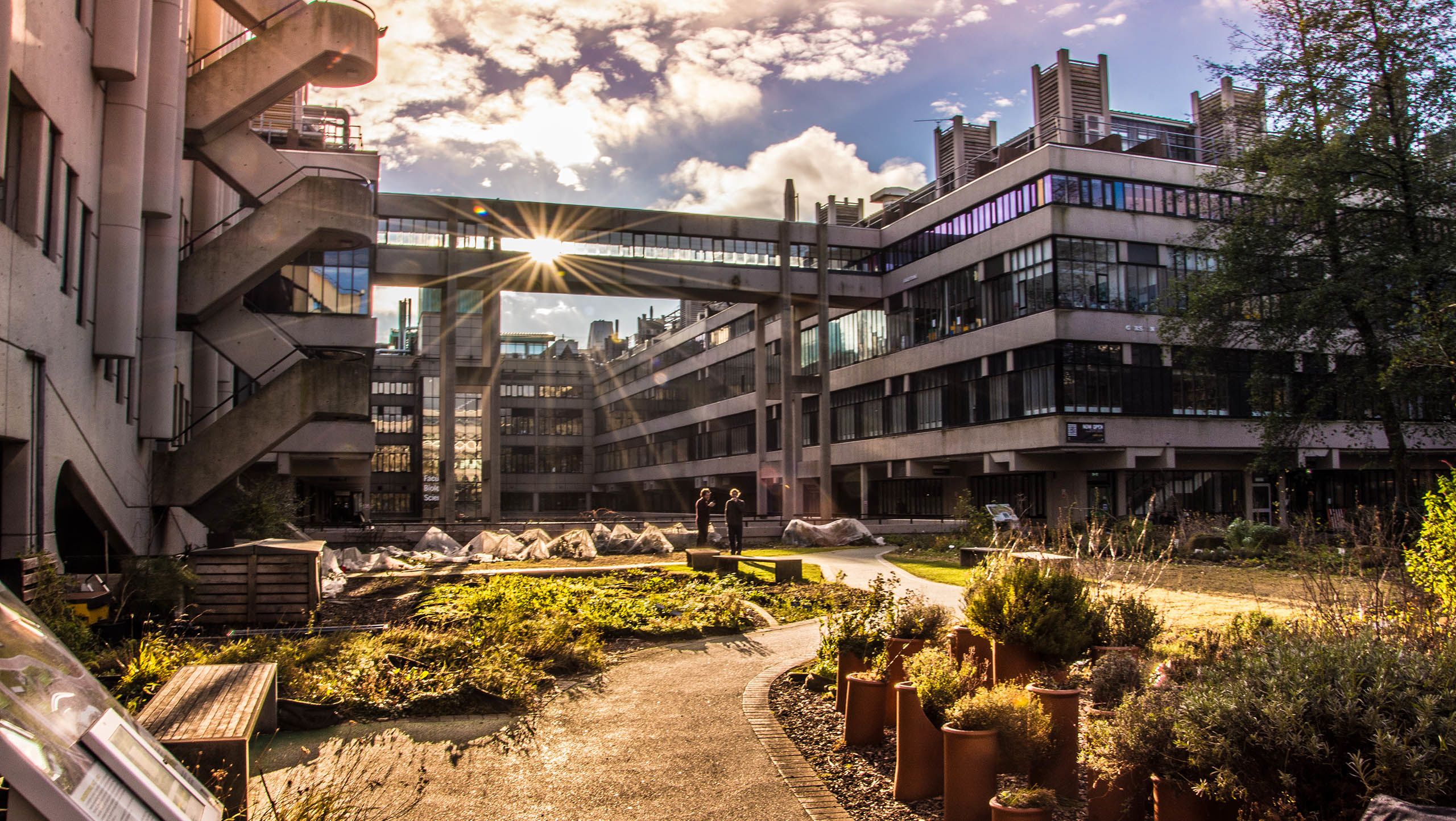
Reducing emissions from our estate requires significant changes to how we heat and power our buildings. This is a major programme of work and takes time. You might not notice big changes on campus, as the projects have been planned to minimise disruption.
The projects in our delivery plan are expected to reduce annual emissions from our estate by more than 35,000 tonnes CO2e per year – a reduction of 81%.
Alongside this we’ll be working out the best way to invest the remaining net zero budget to deliver even more emissions reductions and reach our net zero target. This will include both infrastructure projects and targeted work to deliver energy efficiency improvements.
What can you do?
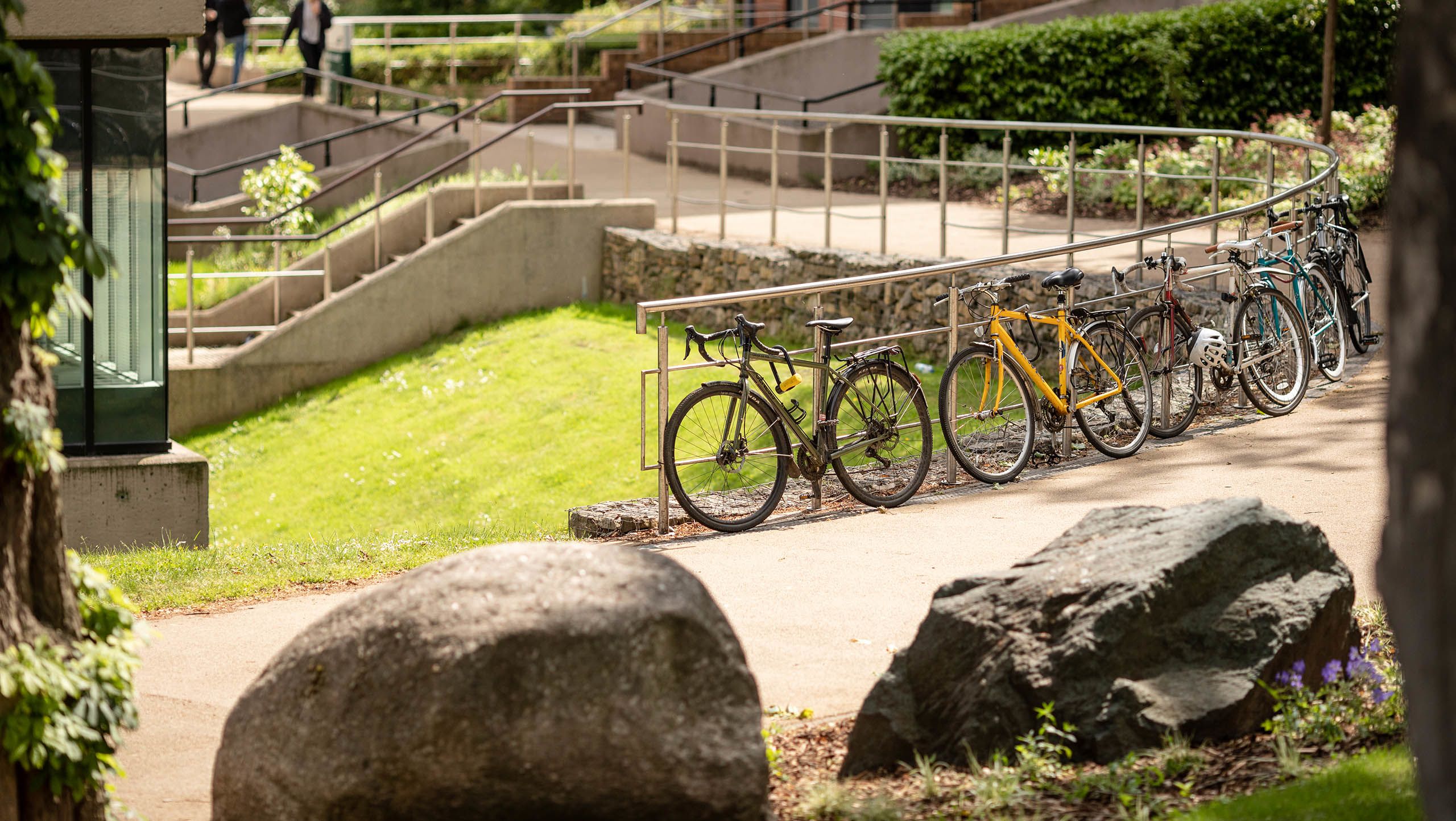
Our Net Zero Delivery Plan also includes investment in programmes that support staff and student engagement with our net zero targets. There are plenty of ways that you can contribute, for example you can:
- Help reduce energy usage across campus, for example by switching off unused equipment overnight, at weekends and holidays. The Energy team have developed a 'good housekeeping guide' (University login required) to help with this.
- Improve sustainability in labs and gain accreditation through the Sustainable Labs programme.
- Embed sustainability in your area of work by becoming a Staff Sustainability Architect or joining the Blueprint programme.
- Contribute to research that helps achieve net zero, with £1m seed funding available through our Living Lab programme.
- Consider the impact of the things you purchase, buying only what is needed, reusing or repairing where possible, and choosing more sustainable options when you do need to purchase.
- Choose the most sustainable travel option that you can, both in your journeys to and from the University and when travelling for business, research or studies away from campus.
If you are a member of staff or student at the University of Leeds, you can access the Climate Plan Sharepoint Hub (University login required) for more information on our Net Zero Delivery Plan, the seven principles that make up our Climate Plan and how you can get involved.
You can also follow our progress towards net zero on our Climate Plan Reporting page.
